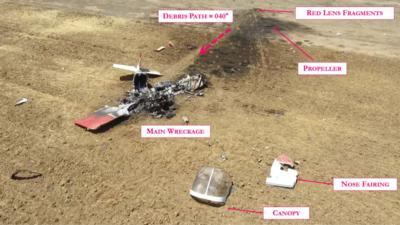Tue, Jul 06, 2021
Footage Revealed That The Airplane Made A Hard Right Bank, With The Wings Near Perpendicular
Location: Porterville, CA Accident Number: WPR21FA223
Date & Time: June 7, 2021, 14:20 Local Registration: N94PJ
Aircraft: Vans RV6 Injuries: 1 Fatal
Flight Conducted Under: Part 91: General aviation - Personal

On June 07, 2021, about 1420, a Vans RV-6A experimental airplane, N94PJ, was substantially damaged when it was involved in an accident in Porterville, California. The pilot was fatally injured. The airplane was operated as a Title 14 Code of Federal Regulations (CFR) Part 91 personal flight. The pilot departed from his home airport in Fresno, California about 1320 and landed at Porterville shortly thereafter.
Numerous witnesses at the airport observed the pilot refuel and takeoff. They stated that the pilot refueled the airplane with about 17.5 gallons at the self-serve fuel tanks located mid-field. A witness observed the pilot, positioned in the right seat, start the airplane after refueling. The start-up was abnormal and sounded as though it was a “hot start” with the airplane rpm’s immediately accelerating to a near maximum setting. The airplane then continued to the departure end of runway 04 and proceeded to takeoff. The airplane began to climb, and the engine was making “popping” sounds while continuing left of centerline. The nose pitched down, and the engine momentarily sounded normal as the airplane then climbed to about 300 ft above ground level (agl). The “popping sounds” continued and some witnesses observed that the engine then experienced a loss of power.
Video footage was obtained from a fixed security camera at the airport. A review of the footage revealed that the airplane made a hard right bank, with the wings near perpendicular to the ground, consistent with the pilot attempting to return to the airport. The witnesses further stated that the airplane then momentarily maneuvered to a wings-level attitude and then rolled left, akin to a snap roll. The airplane then rapidly descended in a left-wing low attitude nearly perpendicular to the terrain and immediately erupted into flames.
The accident site was located about 250 ft from the approach end of runway 12 on flat terrain composed of hard, dry dirt and short vegetation. The wreckage was found distributed over an approximate 40-foot distance with the nose pointed on a median magnetic bearing of about 350°. The fuselage and inboard sections of the wings had been consumed by fire. The first identified piece of debris was fragments of red lens, consistent with the tip of the left wing contacting the ground at the beginning of the accident sequence. From the lens fragments was pieces of propeller blades and pieces of the skin.
More News
From 2023 (YouTube Edition): "Ain’t Your Daddy’s Super Cub”—Don Wade Co-owned by Don and Ron Wade—the former of Don’s Dream Machines, a storied >[...]
Pilot-Rated Passenger Reported That The Pilot Did Not Adequately “Round Out” The Landing Flare And The Airplane Bounced And Yawed To The Right Analysis: The pilot state>[...]
Dead Reckoning Dead reckoning, as applied to flying, is the navigation of an airplane solely by means of computations based on airspeed, course, heading, wind direction, and speed,>[...]
Aero Linx: Lake Amphibian Club This website is created and sponsored by the Lake Amphibian Club, to help spread the word about these wonderful, versatile amphibians that can land j>[...]
“I am deeply honored to be sworn in as NASA administrator. NASA’s mission is as imperative and urgent as ever — to push the boundaries of human exploration, ignit>[...]
 Classic Aero-TV: In Praise of Alabamas Patriot Aircraft USA
Classic Aero-TV: In Praise of Alabamas Patriot Aircraft USA NTSB Final Report: Cirrus Design Corp SR22
NTSB Final Report: Cirrus Design Corp SR22 ANN's Daily Aero-Term (12.21.25): Dead Reckoning
ANN's Daily Aero-Term (12.21.25): Dead Reckoning ANN's Daily Aero-Linx (12.21.25)
ANN's Daily Aero-Linx (12.21.25) Aero-News: Quote of the Day (12.21.25)
Aero-News: Quote of the Day (12.21.25)



